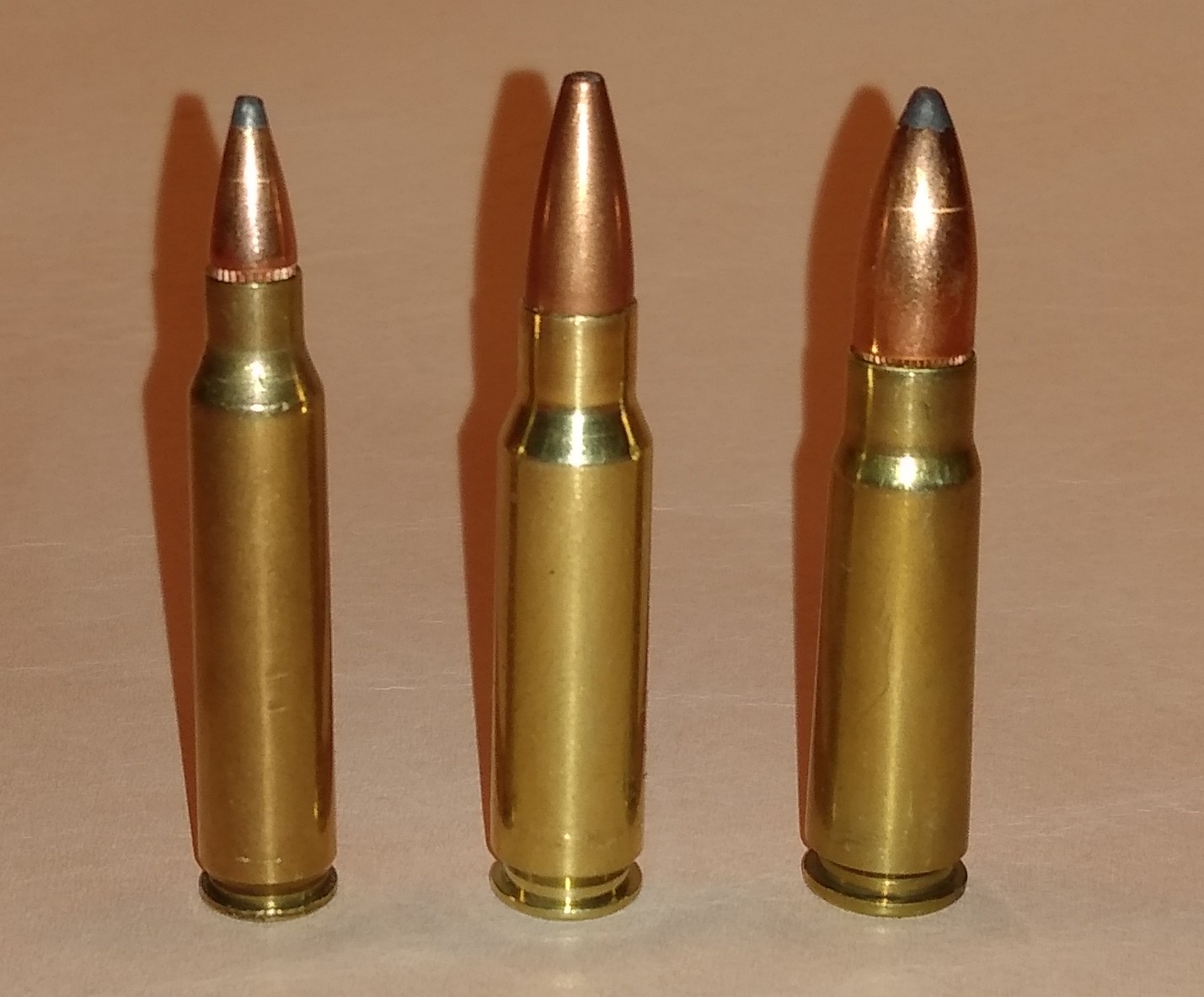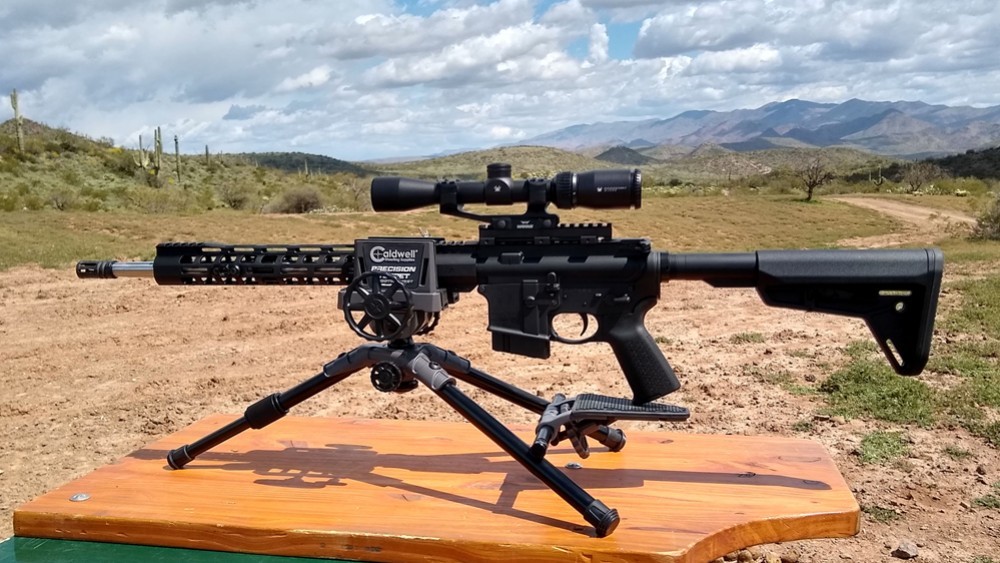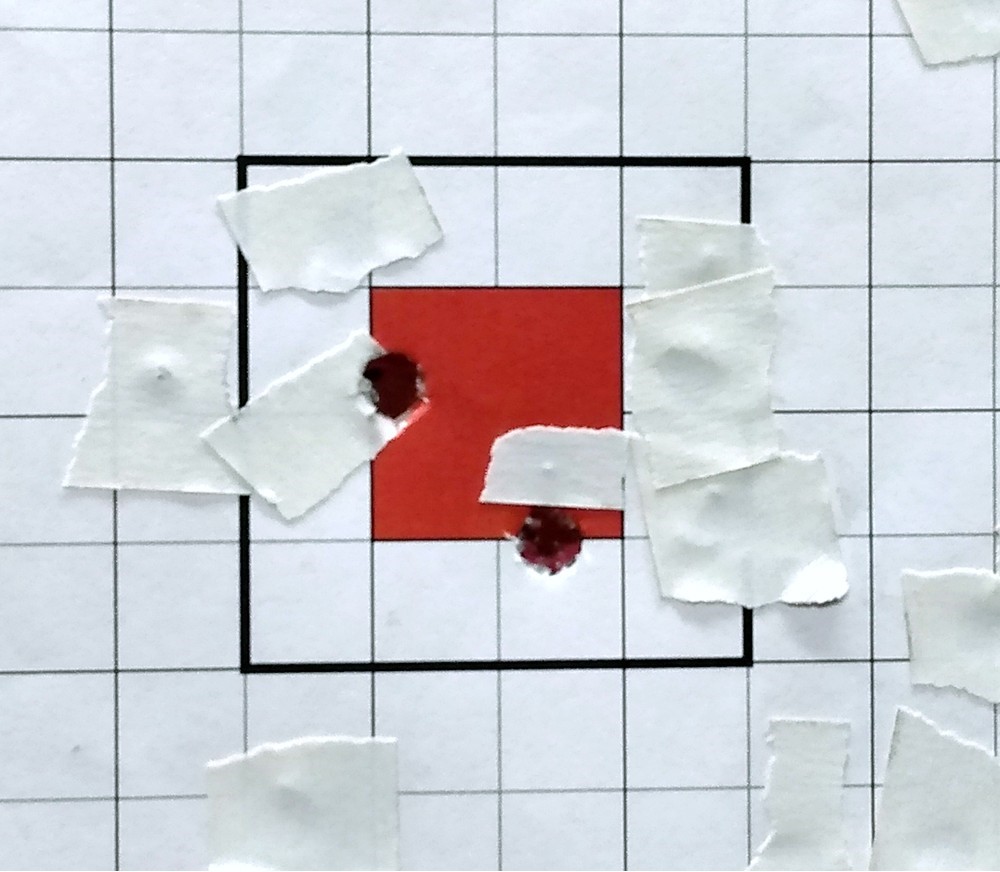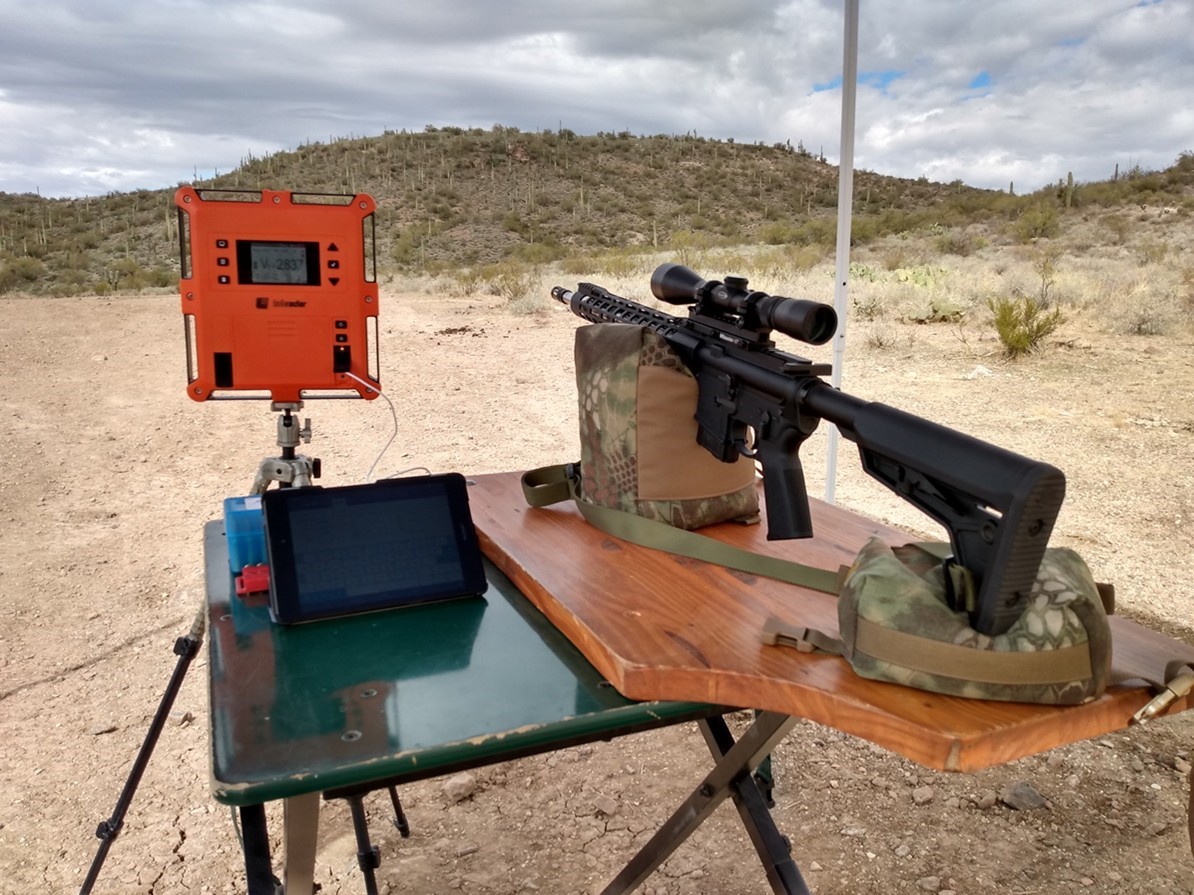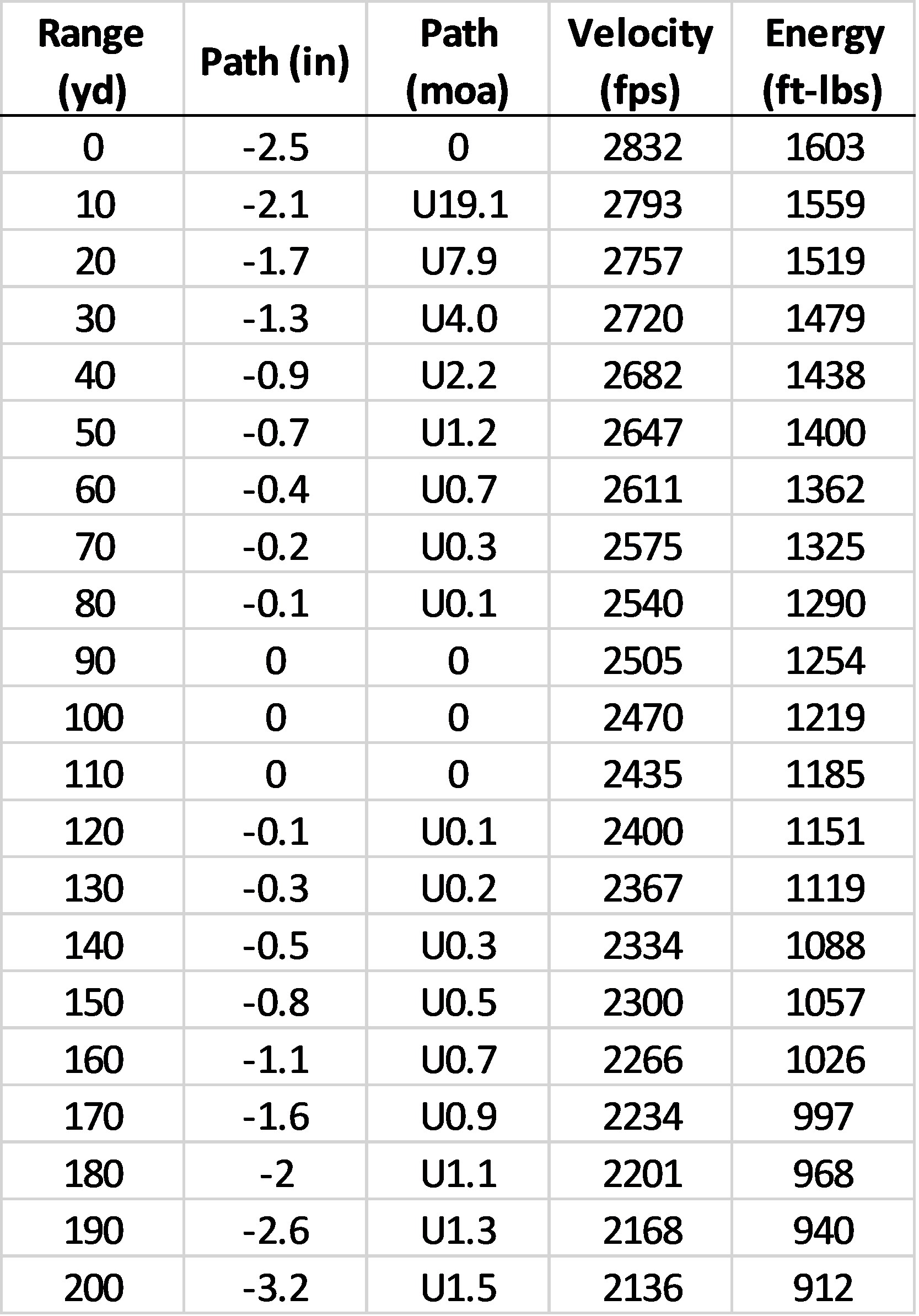
| Articles | Documents | Equipment | Events | Links | Membership | Miscellaneous | Scrapbook | Targets | What's New |
| An AR Purpose-Built for Hunting | March 2021 | ||||||||||
| Dan Martinez | |||||||||||
|
It’s been a back-burner goal of mine to take game with an AR, something that
I still have not yet done. The goal remains open today, after a deer season
and a javelina season have passed since I started this project. The deer
season passed without success because the rifle wasn’t quite ready. The
unsuccessful javelina season was strictly due to the piggies not showing up
when I needed them to.
OK, when I say that this is a big game hunting AR, I mean specifically those
two critters, javelina and deer. I was not interested in an AR-10 platform
rifle, which might also allow me to think about going after elk. An AR-15 is
lighter and easier to carry afield than an AR-10.
So that decision right there limits the possible cartridge power level to
those that remain under 2.26” in overall length. There have been a number
of recent cartridge developments that have allowed the AR-15 to become a bona
fide deer rifle out to at least the 200-yard mark. By that I mean punching a
hole bigger than 5.56mm and carrying in the neighborhood of 1000 ft-lbs. of
energy to that distance or farther. Some of those recent cartridge developments
include the 6mm ARC, the .350 Legend, the .300 BLK, the 6.5mm Grendel, and the
6.8mm SPC.
It was the 6.8 SPC that caught my eye some time back. I actually bought a box
of 115 gr. American Eagle 6.8 SPC before I had anything to shoot the cartridges
with. When I did clock this load, I saw 2568 fps for muzzle velocity. Running
the ballistics, I was surprised to see that this load carries at least 1000
ft-lbs. to 270 yards! Out of an AR-15!
I was strongly considering getting a 6.8 SPC rifle barrel for my Contender frame.
But then I would also need to get a carbine buttstock, a carbine fore-end, a scope
mounting base, rings, scope, the list goes on.
But then I saw Palmetto State Armory advertise an 18” upper in 6.8 SPC that looked
to be exactly what I would want to start a 6.8mm AR hunting rifle build. I could
put it on a lower that I already had, potentially saving some money, and end up
with a repeating rifle that the 6.8 SPC was intended for, instead of just a
single-shot.
Yeah right. You know that the saving money thing never works out. I wish I
could say that this was as easy as tinker-toying the rifle together, sighting
it in, and going hunting, but the truth was actually much more painful.
The Cartridge
In 2003, members of the Army’s 5th Special Forces Group and the Army Marksmanship
Unit collaborated to design a new cartridge which would be a significant
improvement in lethality over the 5.56mm NATO round. This cartridge was intended
for use in the Mk12 Special Purpose Rifle. The SPR was an “enhanced carbine,”
chambered in 5.56 NATO, which filled the role of a Designated Marksman Rifle for
the Special Forces. The military wanted a cartridge with more punch for this DMR,
which was an M16/M4 based platform.
After extensive testing of various calibers between 5.56 and 7.62mm, the Army team
chose caliber 6.8mm as the sweet spot. To American sportsmen, this bullet diameter
is better known as .277”, used by the .270 Winchester since 1925. Being a smaller
cartridge, the 6.8mm SPC would use lighter bullets than are typically used in the
.270 Winchester, but significantly heavier than the 77 grain Mk262 5.56mm round
being used in the Mk12 SPR.
Similarly, after considering various case sizes, they chose the 1906 vintage .30
Remington cartridge as the basis for the new Special Purpose Cartridge. The .30
Remington was originally designed as a rimless competitor to the Winchester
.30-30. It was the happy medium in size between the 5.56mm NATO and the 6mm PPC
case sizes.
The 6mm PPC was derived from the .220 Russian, which was derived from the 7.62x39.
These cartridges all share the head size of .445”, as does the 6.5mm Grendel and
the 6mm ARC (with small differences).
For the military, there was concern that this larger head diameter removes too
much material from the locking lug area of the bolt of the M16/M4. The fear was
that this may lead to reliability problems due to the lugs cracking. The head and
body diameter of the .30 Remington is .422”, providing greater powder capacity than
the 5.56mm with a head and body diameter of .378”, but better perceived reliability
than the larger 7.62x39-derived cases.
The Army team then turned to Remington to further develop the cartridge for mass
production. This is where the FUBAR occurred. When Remington finalized the spec
for the chamber reamer, they ended up specifying the leade, or freebore, too short
at .050 inches. As a result, Remington could not produce ammunition that achieved
the velocity goal set by the Army without running into pressure limits. This
failure effectively sealed the fate of the SPC with the military. They never adopted
it.
The faulty reamer spec was submitted and approved by SAAMI before anyone realized
the problem. So basically, the original SPC spec is now written in stone.
Commercial ammunition must be made to fire in SAAMI chambers, and is therefore
velocity-limited to stay within safe pressures.
Specialty manufacturers and the user community then picked up Remington’s dropped
ball and ran with it. A “Spec II” reamer design was developed that increased
freebore to .100”. Additionally, the twist rate was slowed from 1:10” to 1:11”,
further reducing pressures. A faster twist is not needed for the shorter and
lighter (than the .270 Win.) .277” caliber projectiles used in the SPC.
However, the 6.8 SPC II spec is not recognized by SAAMI. This means that
handloaders can achieve the cartridge’s original design parameters of up to
200 fps greater velocity compared to commercial ammunition, but ammo companies
cannot.
The downside is that unless a user has some way to measure pressure, it’s a
bit of a guessing game once you go beyond published load data. The published
data, just like everything provided by the industry, must adhere to the
original SAAMI spec.
Most every rifle and upper produced today is made to the SPC II spec. There
is no harm in gun manufacturers producing Spec II guns since the result will
be lower pressure when using SAAMI compliant ammunition.
The Upper
First Shots with the AR-6.8
Then I needed everything to handload for the 6.8; dies, cases, bullets. The
primers many resources on the web recommended were the white box CCI #41
military style small rifle primers for 5.56mm.
The best deals for bullets were from Speer. For plinking and practice, the
90 grain Speer TNT hollow points were quite affordable. These are varmint
bullets. For game hunting bullets, it was Speer Gold Dots in both 90 grain
and 115 grain weights. These were also quite affordable, yet they are bonded
soft points that many users reported great success with hunting hogs.
I assembled the upper onto an Aero Precision lower with an A2 buttstock that
I had put together several years ago for a heavy barrel 18” 5.56mm upper that
I had also purchased from Palmetto State. I had installed a very nice Elftmann
trigger on this lower.
Since the deer season was coming up, using book data, I created a ladder of
loads for the 90 grain TNTs and the 115 grain Gold Dots. The TNT loads were
intended for break-in, practice, and getting a basic sight-in before moving on
to the 115 grain loads intended for deer hunting.
If you noticed in the specs, this upper came equipped with an adjustable low
profile gas block. The upper was shipped with a long skinny Allen wrench to
allow adjustment of the gas screw located at the forward end of the gas block.
So I started messing around with the gas adjustment. I finally loosened it to
the point that it ejected forward onto the desert floor never to be found again!
I never did achieve reliable lockback before I lost the adjustment screw. My
range day was done.
Okay. I decided that the adjustable gas block was of no benefit to me. At
full open it did not resolve my problem, so I placed an order for a standard
non-adjustable low profile gas block. I was now going to learn how to replace
a gas block.
I struggled with this problem for the next couple of months. I tried wet
lubing the bolt carrier, different magazines, a low power buffer spring. The
buffer itself was a carbine buffer which was as light as you could go. I gave
myself a real education in AR-15 gas system tuning.
Finally, I decided that my next step was to do the irreversible. In reading
the reviews for my 6.8 upper on the PSA website, I saw that another guy had
the same problem. He said that he drilled the port and fixed the problem. That
gave me the courage to give it a try. But what size? I took the upper apart
again and found that by testing with various drill bits, the hole appeared to be
5/64”, or .078”. Then I dug around on the web and found the chart below. My
barrel is 18” long, which is not in the chart. But .086” is listed as max size
for a 16” barrel, and the min size for a 20” barrel, so I figured it has to be
“just right” for an 18” barrel. .086” is also known as a #44 drill bit. I
ordered one on the web and waited for it to arrive.
When it did, I chucked it into my drill, held my breath, and did the deed. I
used a drop of oil, and it was swift and painless. Whew! Now would it work?
In my education on AR-15 gas system tuning, I ran into the image below. It
shows where your shells should be ejecting based on the tuning of your gas
system:
Perfect is 90° ejection. Overgassed ejects forward, undergassed ejects to
your rear. With some of my 115 grain handloads, I was now seeing 90° ejection.
But with most of my handloads, particularly my 90 grain handloads, I was still
seeing undergassed ejection. Nevertheless, my short-stroke stoppage problem
seemed to be cured!
Mind-you, this is still with the weaker buffer spring installed. I may still
be undergassed, but now at least on the good side of reliable operation. I am
hesitant to go to the next size larger in gas port size, but maybe I need to.
If I then ended up being overgassed, there are things I could do, like go back
to the standard buffer spring, or a heavier buffer, or go back to an adjustable
gas block.
Here's another point to consider: I tend to be a conservative handloader.
None of my loads so far have exceeded maximum book charges. Could it be that
I am undergassed simply because I have a Spec II chamber? It could be that my
loads are simply too low-pressure in that chamber. Maybe it’s time to start
pushing past maximum book charges to see what the SPC II is really capable of.
Load Testing for Deer Hunting
This rifle was not compatible with my favorite one-piece mechanical gun rest.
My rest is made for traditional rifles and would not allow the fore end to
nestle down on the front bag because of the protruding pistol grip. I needed
an AR compatible gun rest to complete my load testing. I got one of these:
The fore end is clamped into a vice-like arrangement and elevation is adjusted
with a twist knob that raises or lowers the platform that the pistol grip rests
on.
I just could not get acceptable groups in my load testing using the 115 grain
Speer Gold Dots using various charge levels of various powders.
Another well-recommended bullet for game is the 95 grain Barnes TTSX. Well,
that ought to do the trick! I’ve always had stellar accuracy results using
Barnes Triple-Shock X-Bullets in other rifles. Also, being a lighter bullet
than the Gold Dots, velocity should also be great. Nope. I was still seeing
group sizes of around 2½ inches at 100 yards with these as well.
Was I having scope problems? The scope I purchased for the rifle was a Vortex
2-7x32mm Crossfire II. For game hunting, I knew that the 6.8 SPC was only a
medium range cartridge. I figured that I did not need any higher magnification
than 7 power. Also, in keeping with the lighter is better theme, I wanted to go
with a physically smaller scope, hence the decision for a 32mm objective lens size.
I had never used a Vortex scope before, but I was impressed when I looked through
the Vortex scopes some of you guys had mounted on your varmint rifles at club
matches. However, the Crossfire II is not one of Vortex’s premium scopes, in fact
it’s one of their most affordable.
I mounted the scope using a Warne X-Skel one-piece AR scope mount. However, when
mounted directly to the rifle’s flat top rail, the scope was a still a little too
low for my face dimensions. I needed to raise it a little higher. I popped down
to Sportsman’s Warehouse to see if they had a “riser for a riser”, as I told the
guy behind the counter. They did. They had a Wheeler Engineering Picatinny riser
that added another .7” to scope height. Hmm. This seemed a little too tall, but I
went with it.
So after I was not able to achieve acceptable grouping, I started wondering about
the scope and the tall mount chain. To take the Vortex out of the equation, I went
to my scope closet and grabbed a Weaver 3-9x40mm scope that I had recently removed
from my .270 Win. when I upgraded the scope on that rifle to a Burris Veracity. I
mounted that to the Wheeler pic riser with standard low height rings, leaving the
Warne X-Skel mount on the Vortex. This was again a little too short for my face,
but it was acceptable.
Back out to the desert for more testing. I was still not able to get the grouping
performance that I wanted to see out of the rifle. Deer season was almost here, and
I was getting real pissed off at this rifle. I decided that it was time to put it
away for now and use my .270 Win X-Bolt for the hunt which I had ultimate confidence in.
Finishing the Rifle
I found myself up at J&G Sales in Prescott where I started to lay my cash down for a
stripped lower by Aero Precision. But then I spotted a complete lower that they were
selling, up on the pegboard behind the salesman. “Hey, what’s that?” He pulled it
down and showed me.
It was a Ruger AR-Lower Elite. Ruger sells this as a standalone “gun” (since it is
the serialized part) for us AR builders. Topping things off, it features Ruger’s
excellent two-stage trigger system, the Elite 452. I am a big fan of two-stage
triggers. The 4-5-2 nomenclature translates to 4.5 pound trigger pull, 2-stage. In
real life, the break comes in at a bit under 4 pounds after taking up the very light
first stage. The break is very crisp and predictable.
The lower also features a Magpul MOE grip and 6-position buttstock. This stock has
some sort of an internal tensioning system that eliminates all rattle. It’s actually
a little stiff to move due to this. Awesome, I’ll take one.
Javelina Season
I was planning to use another of my ARs, my budget Del-Ton Sport on which I had
recently mounted a 3x prism sight. I remain leery about using a little .22 caliber
bullet on “big” game, but I knew a guy who used to go after piggies every year with
a .22 Magnum, and he swore by it.
But then, about two weeks before the hunt, it dawned on me that I had never done any
testing with the 90 grain Gold Dots. I had been concentrating on getting it ready
for deer hunting with the 115 grain Gold Dots. The 90 grainers should be perfect
for the little piggies, and much better than any .22 caliber bullet out of the Del-Ton.
I threw together a batch of ammo using the 90 grain Gold Dots and just went with
the maximum book charge using Alliant Reloder 7. Of the powders listed for this
bullet, Reloder 7 was near the bottom for velocity, but it was what I had on hand.
It was time to go back out to the desert for another range test. I set up a
target at 100 yards, took two shots and this is what I saw:
From there I proceeded to have some fun popping 12 ounce plastic soda bottles at
100 yards, reliably hitting them. But there was one major difference from my last
sight-in session.
Since nothing else I tried to cure the accuracy problem seemed to be working, I
started to wonder about that new AR gun rest. One problem that I had with it was
that no matter how hard I tried to clamp the fore-end with the vice, the recoil of
the 6.8 would cause the fore-end to rotate in the vice. Periodically, I would have
to loosen the vice, reset the fore-end to rest flat again, then re-tighten. I began
to doubt that a tightly clamped fore-end was a good way to rest the gun for accuracy
testing. This time I used bags. They weren’t the best rock-steady bags around, but
still they allowed the rifle to more freely recoil.
Ignore the LabRadar chronograph in the photo for right now. It will likely be the
subject of some future story. However, it did allow me to measure speed which clocked
in at an average velocity of 2832 fps for this load. So here is the data for that,
zeroed for 100 yards:
In the Field
I hunted with the Howa for only one day. In my
story about that rifle, I mentioned its one major weakness. The way that the
detachable magazine is retained leaves it highly vulnerable to being accidentally released.
While walking in the field, I accidentally released the magazine just carrying the rifle over
my shoulder. I ended up walking with a round in the chamber, but the magazine in a pocket to
avoid the chance of dropping the mag unnoticed. This is not good if action needing multiple
shots should suddenly be required.
By contrast, I was totally delighted by the way the PSA/Ruger AR-6.8 carried. Since it
is a dedicated hunting AR, I only have three 10-round magazines for it, no hi-caps.
Hi-caps would only be in the way on a hunting rifle.
For the most part, the rifle hung well on my shoulder. It didn’t try to keep falling off.
When carried in the hand, the balance point is right at the front of the magazine well.
The total field weight scoped, with sling, and the magazine loaded with 5 rounds, ended up
right at 8½ pounds. Lighter would have been nicer, but that’s not bad. That’s a good
all-up field weight for any hunting rifle.
The biggest problem I had with field carry of this gun was on those cold mornings. All
metal construction (okay, except for the Magpul parts) transmits the cold right into your
hands. I could feel the cold right through my Mechanix Wear camo gloves. It was best to
leave the gun over my shoulder until the day warmed up a bit.
Man, I really wanted to find those piggies to finally take a game animal with an AR, but
it was not to be. I hunted for 5 days straight without seeing any. Anyway, it’s good to
get out in the field with a new rifle. Maybe next season.
In the meantime, I will try again with the heavier bullets to see if I can get the gun to
shoot those with accuracy. At this point, I really believe that the accuracy problem I was
having lies with the rest. Plus, I will try to cautiously go past maximum book loads to
test functional reliability, ejection pattern, and velocity. Maybe I will also mess around
a little more to optimize the scope setup.
| |||||||||||
| If you enjoyed this story, or found it useful, please consider clicking here to join the NRA at a discount of $15 off the normal membership cost. You will be supporting both this website and adding your voice in support of the Second Amendment. Thank you very much. |
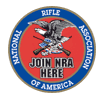
|

|
|

